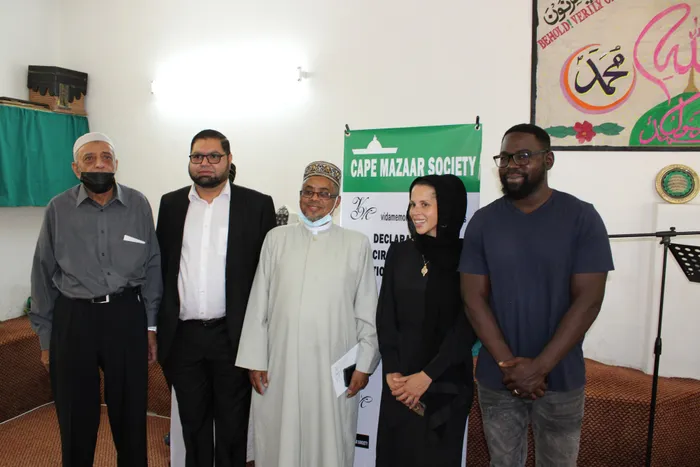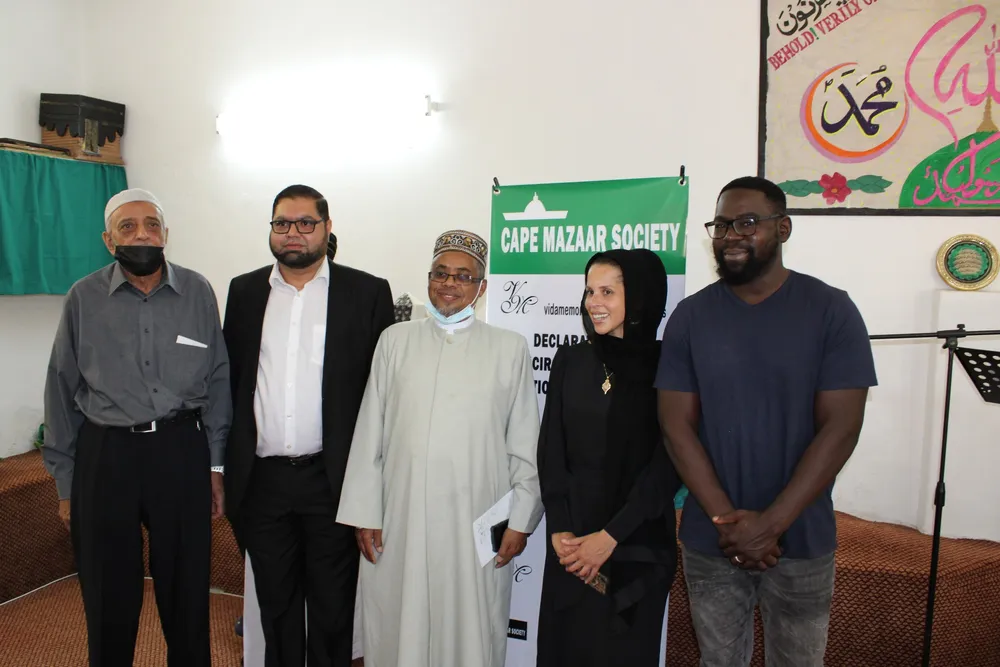Kramat declared national heritage sites

From left, Mahmood Limbada, chairperson of the Cape Mazaar Society, Yusuf Khan Dalwai the Cape Mazaar Society PRO, President of the Cape Mazaar Society Shaykh Abduraghman Alexander, Quahnita Samie from Vidamemoria heritage consulting and SAHRA Built Environment Manager Ben Mwasinga.
After nearly 40 years of campaigning, 10 kramats in Cape Town have been granted national heritage status.
The announcement was made at the Sayed Abdul Malik Kramat in Vredehoek, last Friday.

This induction was made possible by the collaboration of the Cape Mazaar Society, Vidamemoria Heritage consultants, and the South African Heritage Resources Agency.
These organisations had campaigned for government to gazette the following kramats as national heritage sites:
- Sheikh Yusuf Kramat in Faure
- Sayed Mahmud in Summit Road Constantia
- Sheikh Abdul Mutalib in Constantia Forest
- Sheikh Abdurahman Matebe Shah in Constantia
- Tuan Dea Koasa and Tuan Ismail Dea Malela in Simon’s Town
- Sheikh M Hassen Ghaibie Shah and Tuan Kaape-ti-low on Signal Hill
- Sayed Moegsien bin Alawieal Aidarus and Sheikh A ibn Muhammad AlIraqi in Mowbray
- Sheikh Noorul Mubeen on the slopes of the Twelve Apostles in Oudekraal.

“In the mid 1980s when we approached the government to preserve these kramats as heritage sites and we were refused by the monuments council, this refusal continued in the 1990’s as well,” said Mahmood Limbada, chairperson of the Cape Mazaar Society.
“In 2009 Quahnita Samie approached us and this movement started again, together with SAHRA we are here.”
According to Quahnita Samie, the Vidamemoria heritage consultant, the process of nominating and declaring heritage sites is outlined in the National Heritage Resources Act, and her company had to undertake the identification and research to establish the kramats' heritage designation.
“Heritage relates to our identity, values, traditions and culture. As a practitioner I often say heritage is a process,” she said.
“The kramats were deemed to be of national significance for many reasons including its importance to the community and pattern of South Africa’s history, its cultural heritage value and strong and special social, spiritual, historical and religious significance.
“The ‘Circle of Tombs’ displays immense intangible significance and is a symbol of resistance, religious freedom and perseverance. Indeed, the kramats at the Cape are a place of sanctity, remembrance and reflection,” said Ms Samie.

The oldest kramat, that of Sheikh Yusuf, dates back to 1699 and there are 30 around Cape Town including one on Robben Island. These mausoleums house the pioneers of Islam, men who were considered pious and who taught the religion of Islam. The chairman of the Muslim Cemetary board, Faizal Sayed, said they shaped the tapestry of Cape Town.
“When they arrived in the Cape over 300 years ago, not only did they teach Islam, they played a role in the freeing of slaves and the importance of these heritage sites, the preservation of the heritage sites is important as they are symbols of our history and the preservation of our future,” said Mr Sayed.

According to Yusuf Khan Dalwai, the Cape Mazaar Society’s PRO, a prophecy was made more than 250 years ago that there would be a Circle of Islam around the Cape, a sacred spiritual circle providing protection and guidance for those within it.
The kramats are also referred to as the Circle of Tombs.
“The recognition of the heritage significance of the circle honours the Auwliyaa (the friends of the Almighty). The kramats are not only places of spirituality but are tangible signs of the emergence and spread of the Islamic faith throughout the Western Cape and the rest of South Africa,” said Mr Dalwai.
The President of the Cape Mazaar Society, Shaykh Abduraghman Alexander, said it was a significant day not only for the Muslim community of the Cape but for all South Africans.
“The kramats are symbols of defiance to the colonial masters and the injustices of the past. They inspire us to stand for justice,” said Mr Alexander.
“The location of the kramats are on the slopes of the mountains, on the hills and in forests because the Auwliyaa had to be out of sight of the slave masters.
“This is where they taught the indigenous people about Islam and they recognised that being part of the quiet and calmness of nature puts you in touch with the Creator. The Prophet Muhammed Peace Be Upon Him also sought solace in the cave of Hira in Mecca, and so this is the way of the Auwliyaa, so if you want to get in touch with the creator then get in touch with nature,” he added.

The kramats have the same status as Robben Island, Table Mountain, Union Buildings and the Liliesleaf farm according to SAHRA’s built enviroment manager, Ben Mwasinga.

“We provided technical expertise, assisting them with the application process and taking them through the necessary steps. Vidamemoria and Quahnita has to be commended for their work. There was zero research done before they came along and they built this data about the kramats,” he said.
“It was an extensive process and I was happy to be of assistance,” said Mr Mwasinga.
The Cape Mazaar Society and Vidamemoria said there were plans to reveal the status of a few more kramats early in 2022.
“We grew up with kramats in our heart and it’s a victory to all of us, not only Muslims, but all South Africans can be proud of this national heritage status,” said Cape Town best-selling author Yusuf Daniels.
